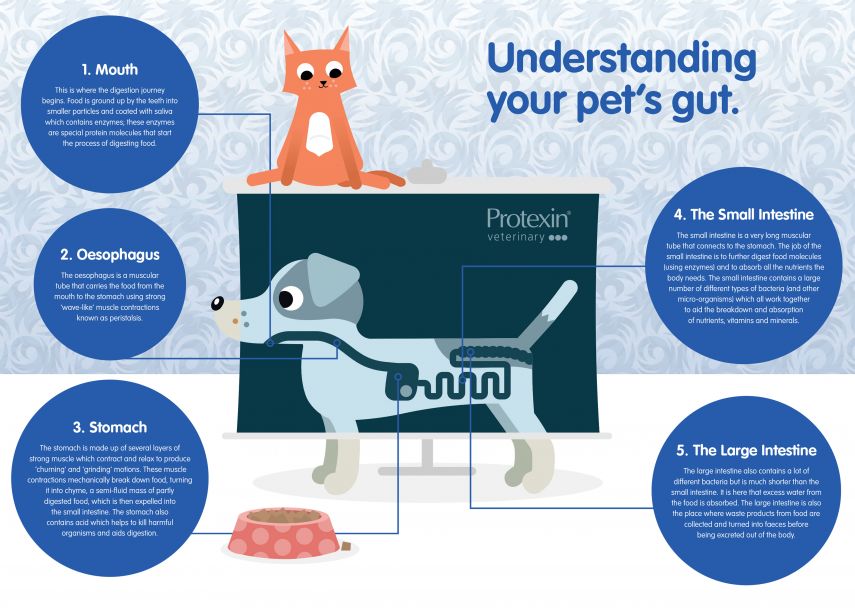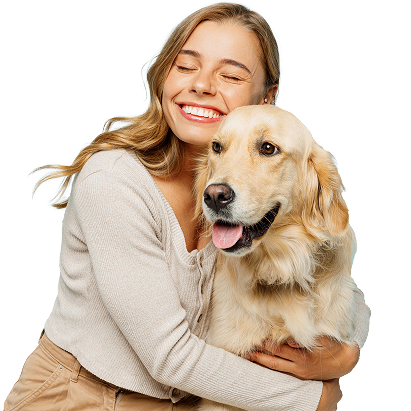Understanding Gut Health
Why is your pet’s gut health so important? When we talk about the ‘gut’ we are really referring to the gastrointestinal tract. This is essentially the path that food takes from the mouth, through the stomach and intestines before reaching the colon and leaving the body as ‘poop’. The gut has several important roles which […]
Why is your pet’s gut health so important?
When we talk about the ‘gut’ we are really referring to the gastrointestinal tract. This is essentially the path that food takes from the mouth, through the stomach and intestines before reaching the colon and leaving the body as ‘poop’.
The gut has several important roles which enable the body to function normally. Firstly, and perhaps most obviously, the gut is where digestion of food and absorption of nutrients occurs – this enables our pets to take in energy and essential vitamins and minerals from the food that they eat. Secondly, the gut is involved in excretion of waste products – both indigestible food, and certain toxins/ by-products of other processes are shed from the body in the stools.
The gut also plays a role in water regulation, with stools becoming firmer when an animal is dehydrated and more water is absorbed. Finally, the gut plays an essential role as part of our pets’ immune system.
Given that the mouth provides an opening to the outside world, anything entering the gut may be able to gain access to the rest of the body, if the gut were not to have the following protective functions in place. The cells lining the gut have tight junctions holding them together, the gut cells are lined with a thick layer of mucus which creates a barrier between the intestinal cells and the contents of the gastrointestinal tract, and finally the gut is home to a huge number of micro-organisms, known as the microbiota, which play a big role in maintaining normal immune function.
The gastrointestinal microbiota also has several other important functions including: digestion of plant fibres, production of certain vitamins, reduction of pathogenic (bad) bacteria, supporting the gut barrier function and creating oral tolerance (the fact that animals can eat food and not have allergic reactions to the foreign material entering their guts).

How does your pet’s digestive system work?
The digestive journey starts when your pet takes food into their mouth. Whilst some very greedy dogs will wolf their food down, barely pausing to chew it, most animals will chew their food before swallowing. Through the action of chewing, their sharp teeth start to break down the food into smaller pieces. Saliva is also released and coats the food, helping to lubricate it for swallowing and providing some enzymes which start the digestive process.
Food then passes down a tube-like structure called the oesophagus to the stomach. Muscular contractions of the stomach create a churning and grinding action and continue the breakdown of food into smaller pieces. The stomach acid helps to kill off certain harmful bacteria and kick-starts the digestion of proteins.
The food then moves into the small intestine where it is mixed with secretions from the pancreas. Pancreatic secretions help to neutralise the food after the acidic environment in the stomach. They also contain enzymes which enable the breakdown of proteins, fats and carbohydrates into small molecules which can be absorbed. The small intestines also contain large numbers of bacteria which further contribute to the digestion of the food, and even make some vitamins which the animal can absorb. As the food passes down the intestines it is digested into tiny molecules which are absorbed across the large surface area of the gut, created by finger-like projections known as villi. (The surface area inside a person’s small intestines is said to be as large as a tennis court!). Following absorption, the food digestion products can travel around the body in the bloodstream; they may act directly as energy sources for cells, be stored for later use, or be incorporated as building blocks for new cells.
The food which is left at the end of the small intestines then enters the large intestines (also known as the colon); this is primarily indigestible plant matter and fibre, though may also include certain waste materials. There are huge numbers of bacteria present in the colon which can ferment some of this fibre to provide a food source for the cells lining the large intestines. In the colon water and salt are reabsorbed depending on the animal’s needs. The stools are stored in the rectum before being excreted when the animal defecates (poops!).
 Pet Owner
Pet Owner 



